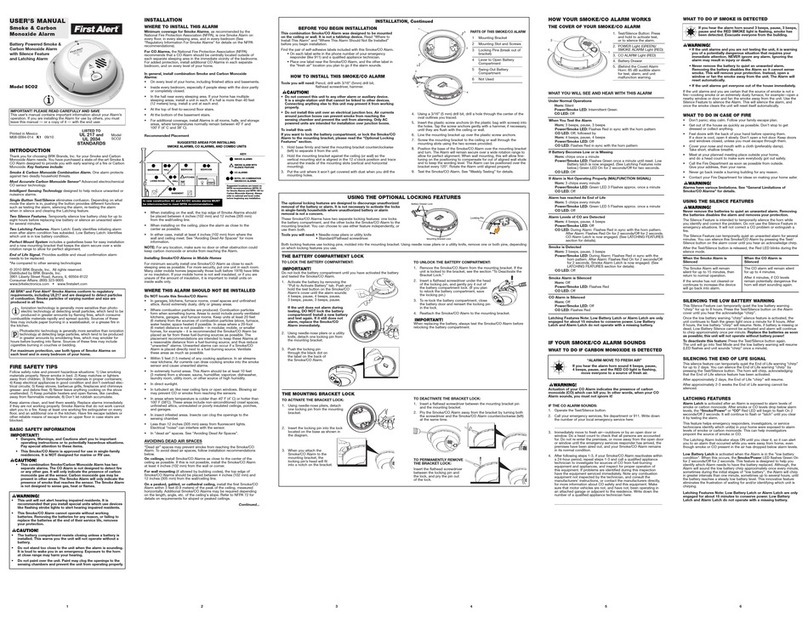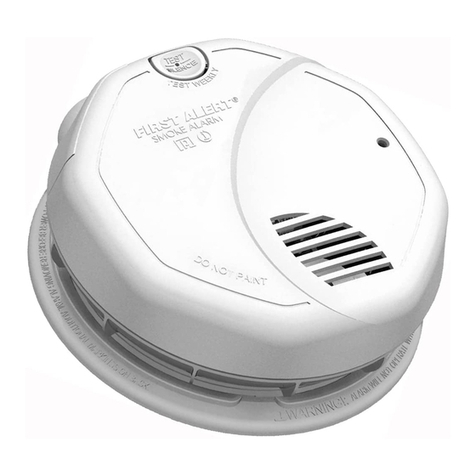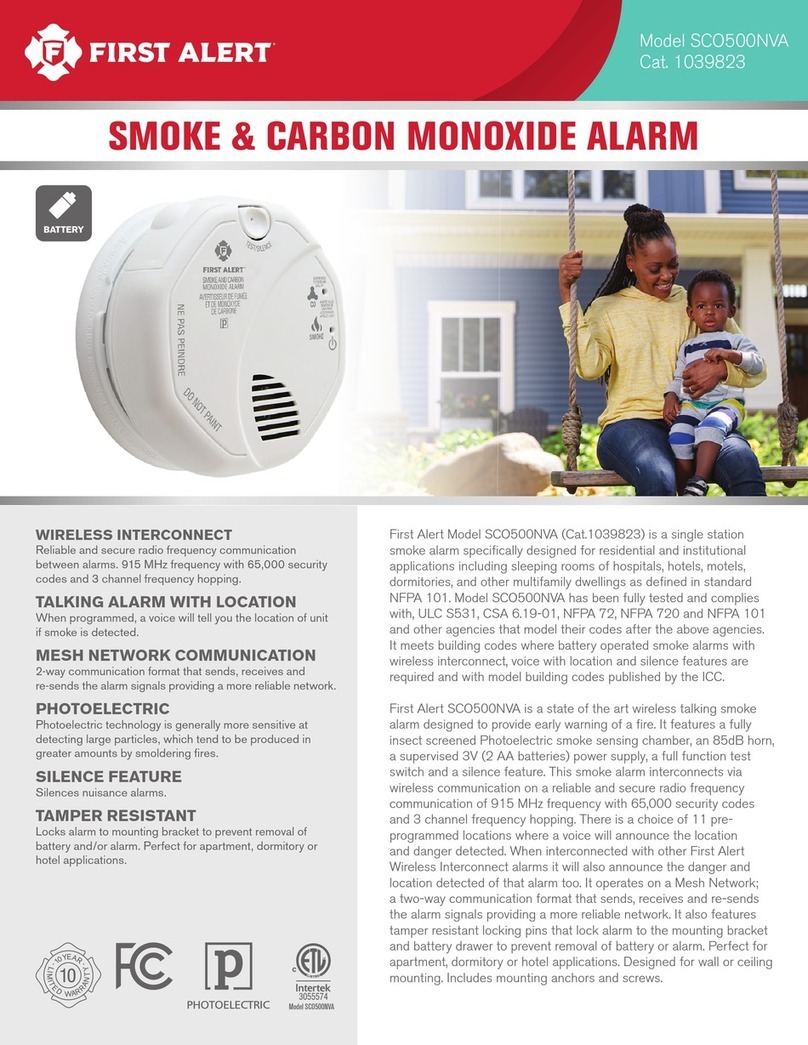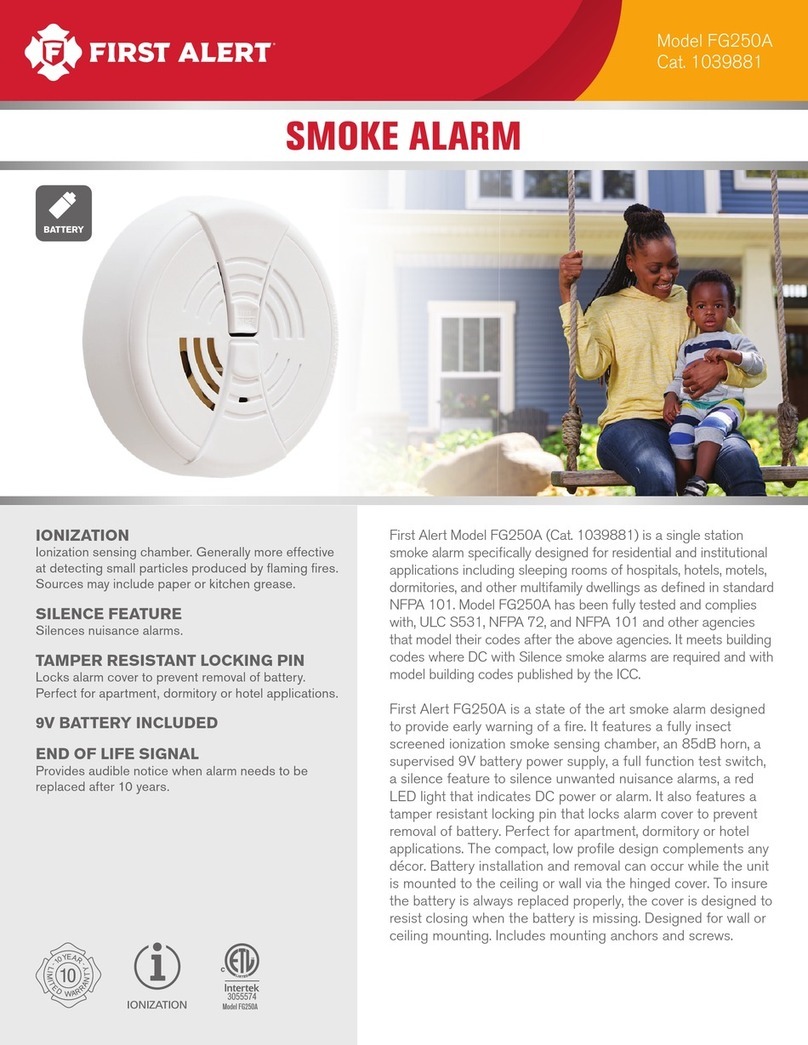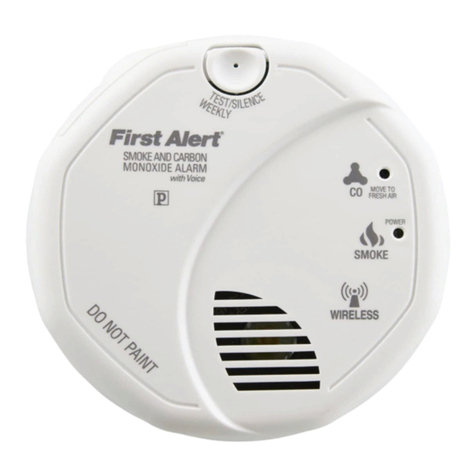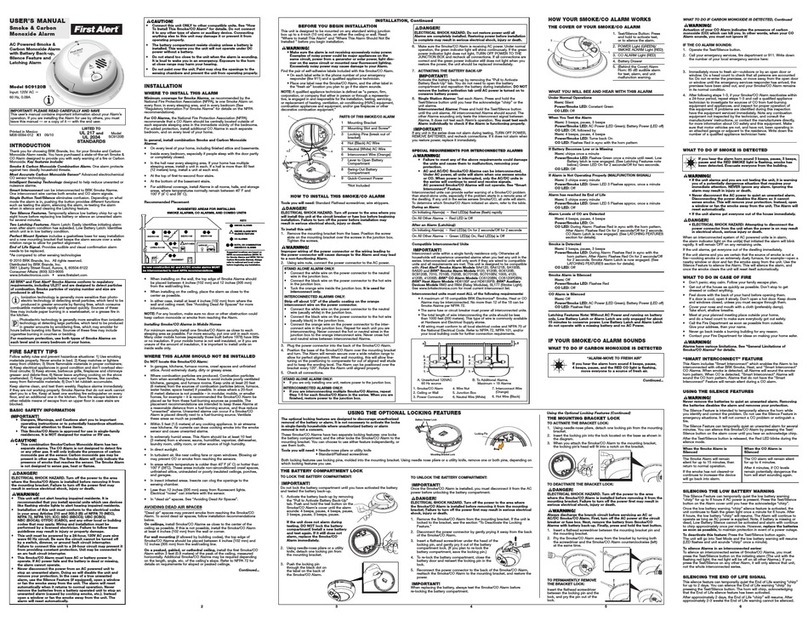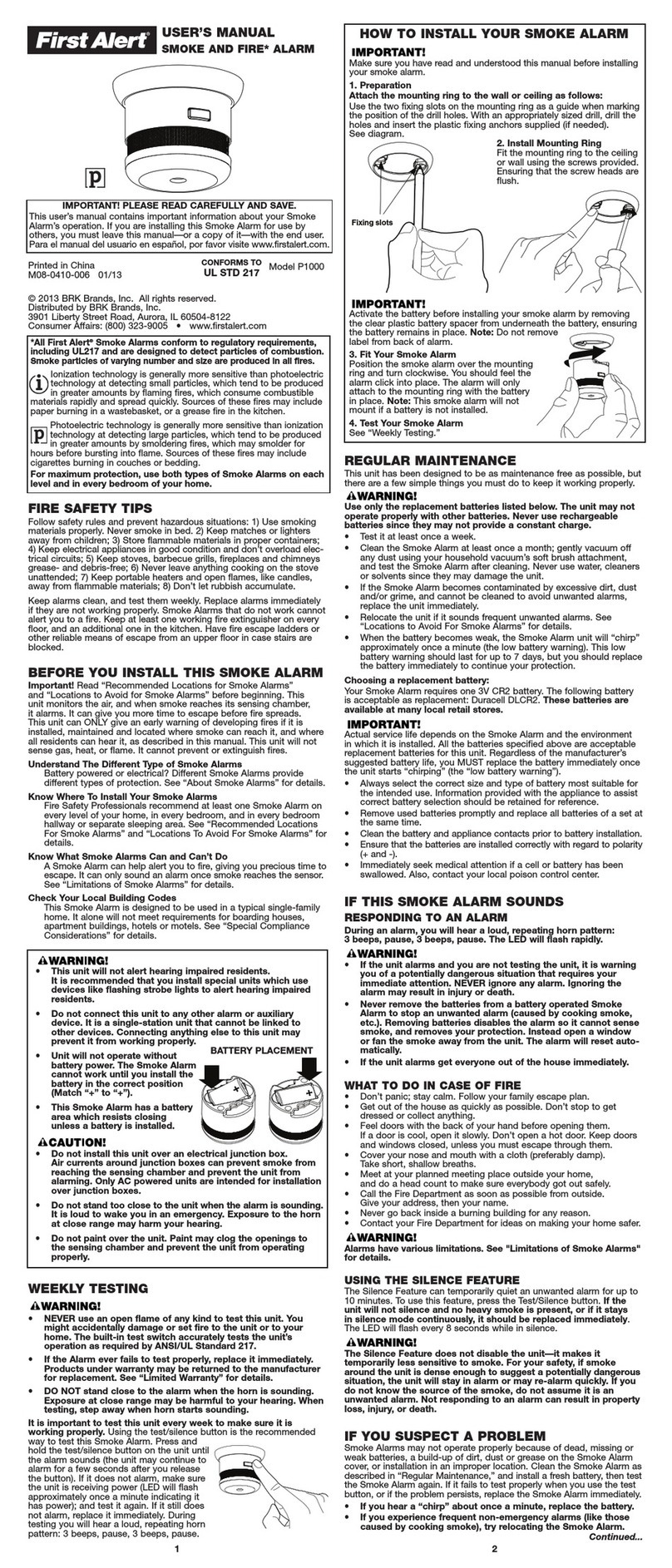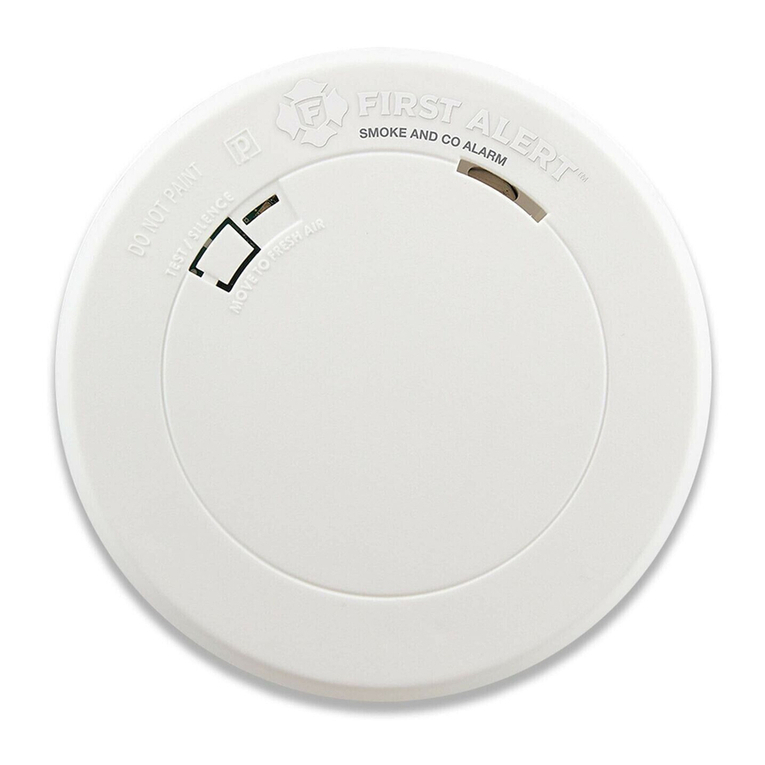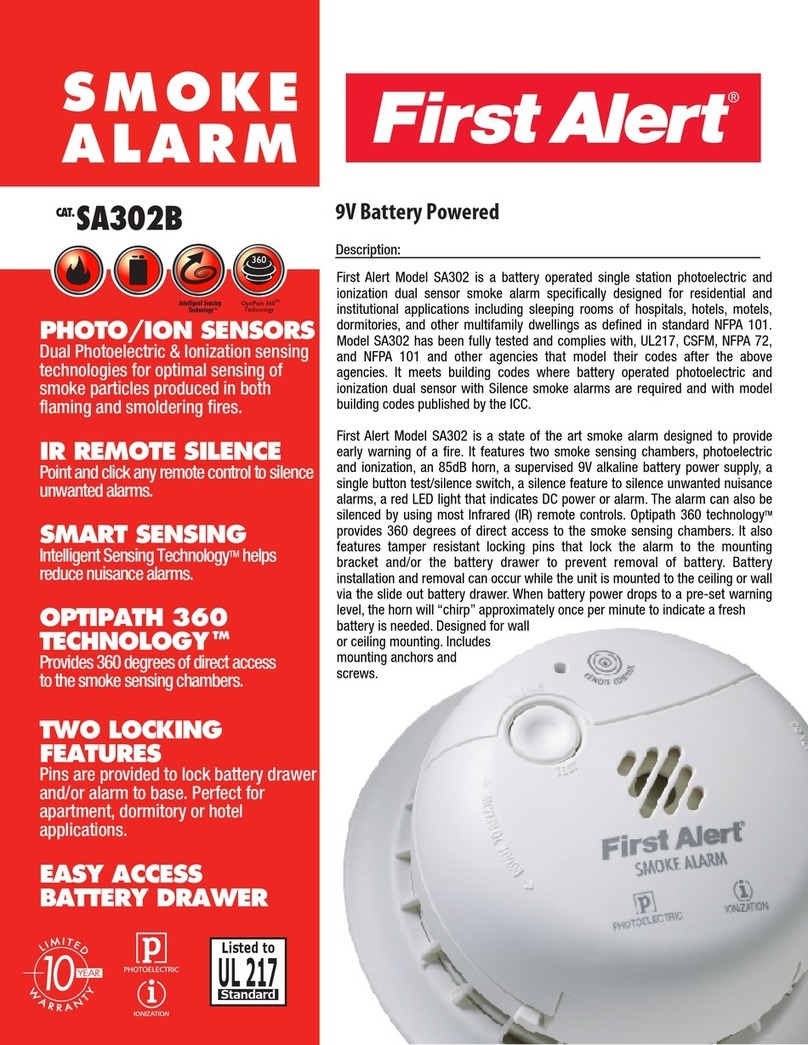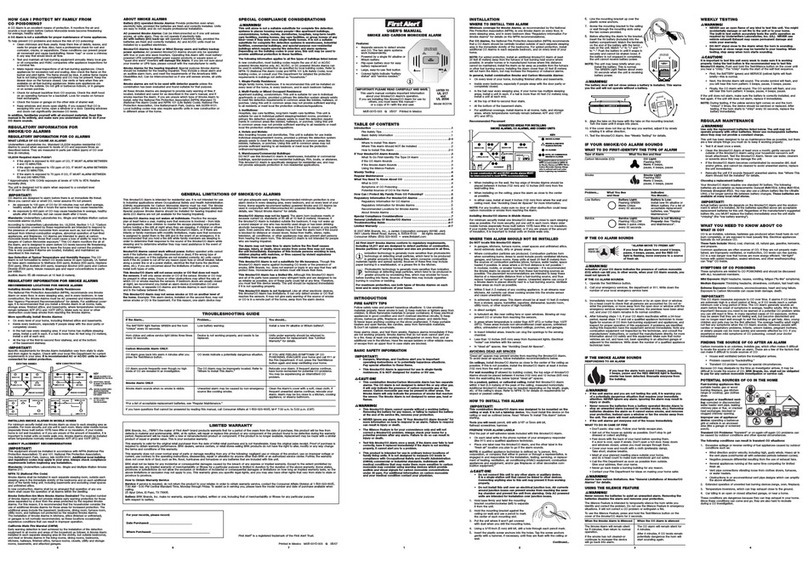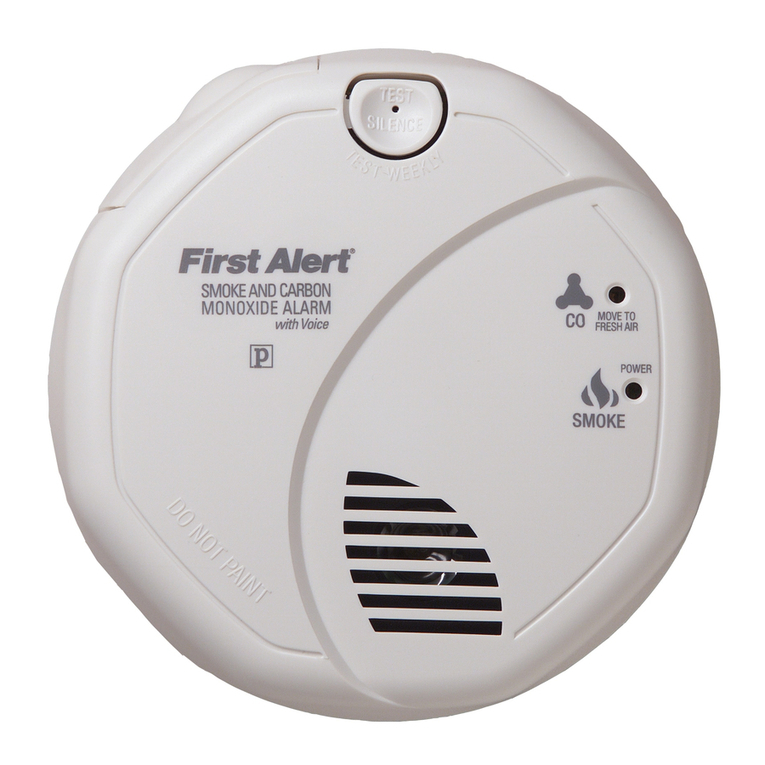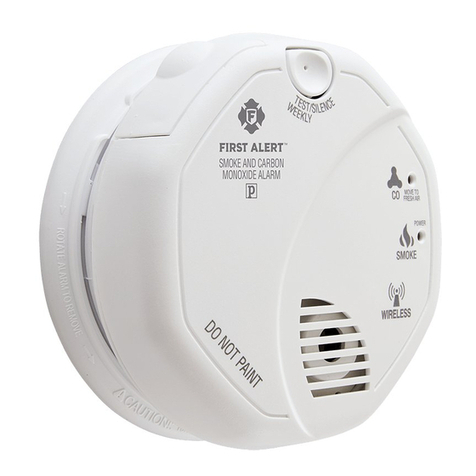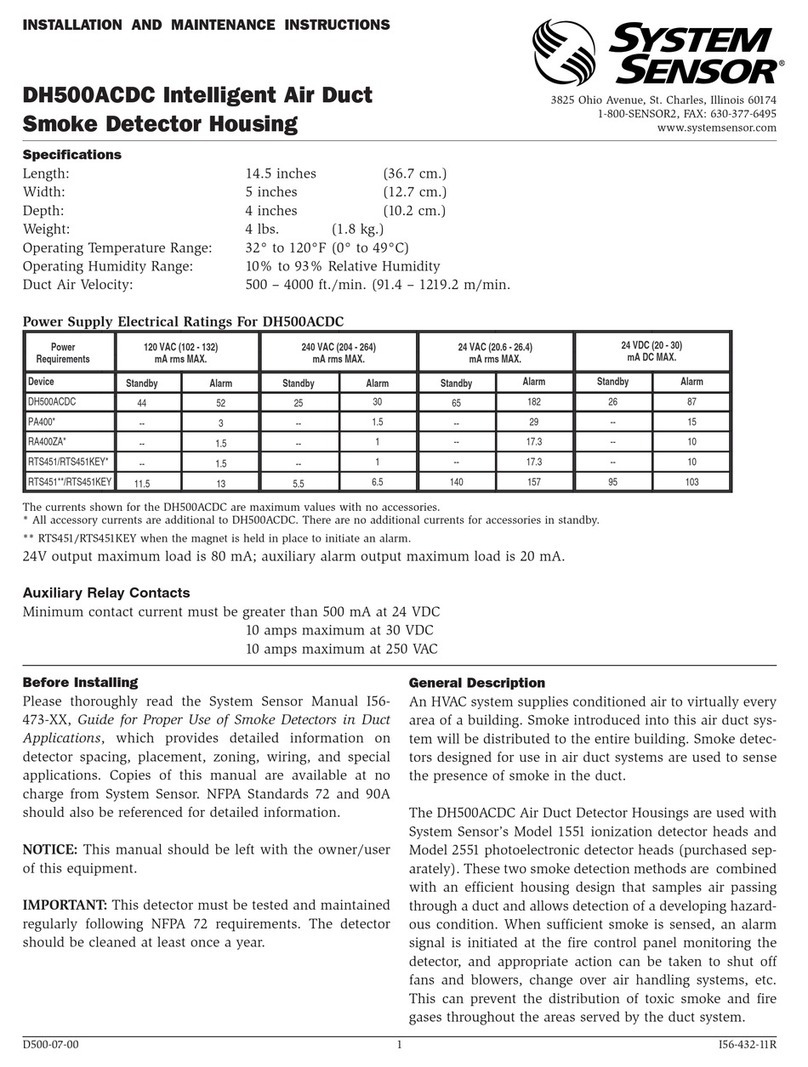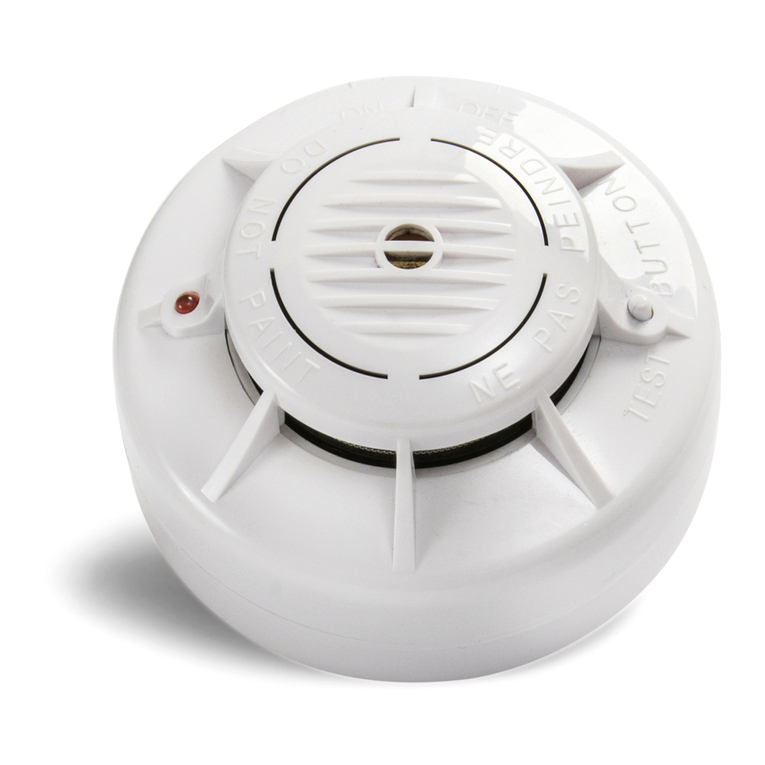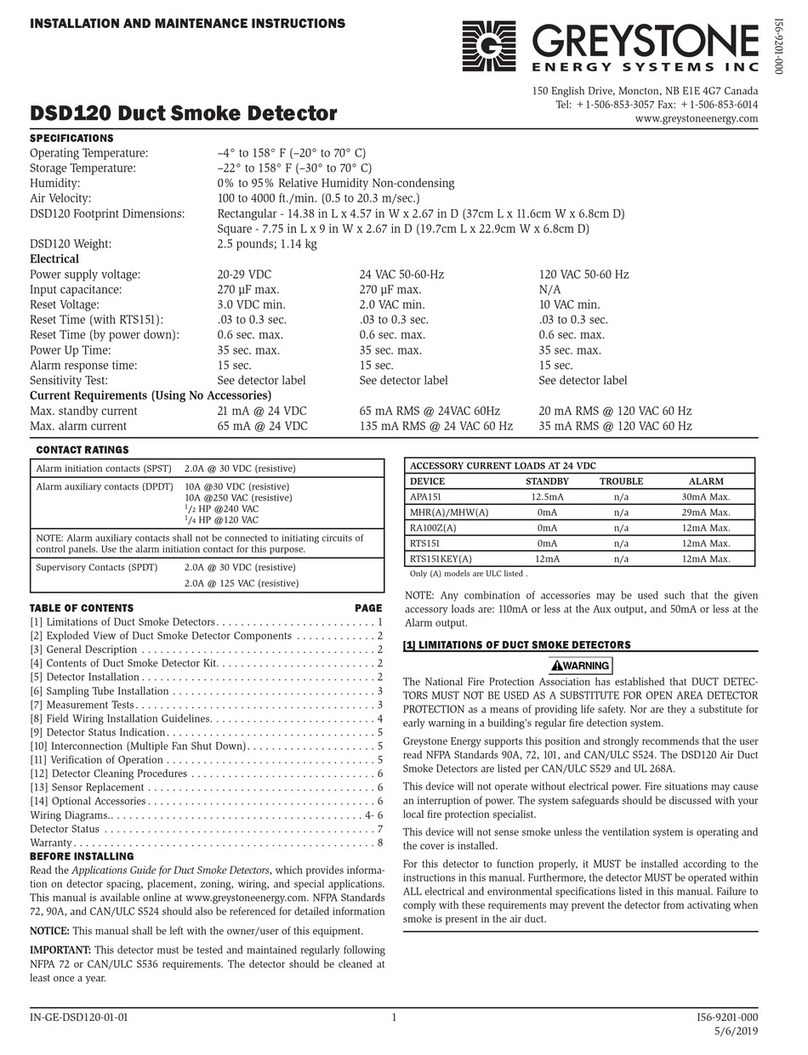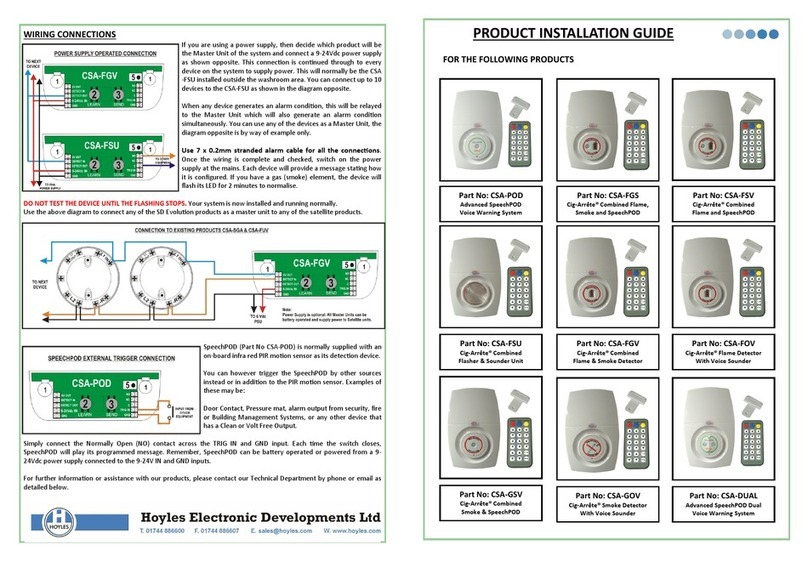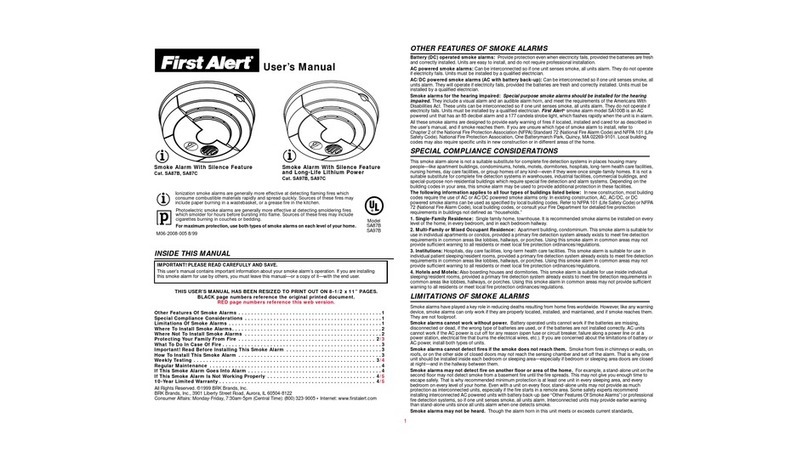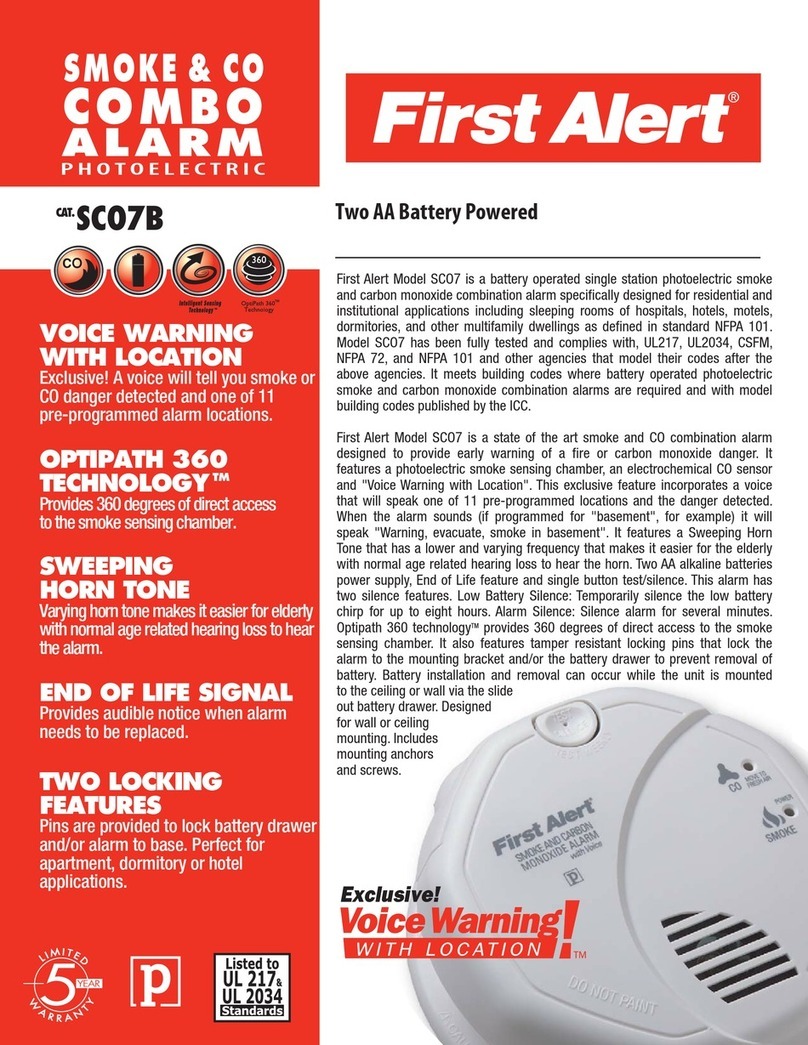5
Model SCO7
M08-0048-016 Q09/12 Printed in Mexico
IMPORTANT! PLEASE READ CAREFULLY AND SAVE.
This user’s manual contains important information about
your Combination Carbon Monoxide & Smoke Alarm’s
operation. If you are installing this Alarm for use by
others, you must leave this manual—or a copy of it—
with the end user.
© 2012 BRK Brands, Inc. All rights reserved. Distributed by BRK Brands, Inc.
3901 Liberty Street Road, Aurora, IL 60504-8122
Consumer Affairs (800) 323-9005 • www.firstalert.com
INTRODUCTION
FIRE SAFETY TIPS
Follow safety rules and prevent hazardous situations 1) Use smoking
materials properly. Never smoke in bed. 2) Keep matches or lighters away from
children; 3) Store flammable materials in proper containers; 4) Keep electrical
appliances in good condition and don’t overload electrical circuits; 5) Keep
stoves, barbecue grills, fireplaces and chimneys grease- and debris-free;
6) Never leave anything cooking on the stove unattended; 7) Keep portable
heaters and open flames, like candles, away from flammable materials;
8) Don’t let rubbish accumulate.
Keep alarms clean, and test them weekly. Replace alarms immediately if they
are not working properly. Smoke Alarms that do not work cannot alert you to
a fire. Keep at least one working fire extinguisher on every floor, and an
additional one in the kitchen. Have fire escape ladders or other reliable means
of escape from an upper floor in case stairs are blocked.
BASIC SAFETY INFORMATION
• Dang rs, Warnings, and Cautions al rt you to important op rating
instructions or to pot ntially hazardous situations. Pay sp cial
att ntion to th s it ms.
• This Smok /CO Alarm is approv d for us in singl -family
r sid nc s. It is NOT d sign d for marin or RV us .
• This combination Smok /Carbon Monoxid Alarm has two s parat
alarms. Th CO Alarm is not d sign d to d t ct fir or any oth r
gas. It will only indicat th pr s nc of carbon monoxid gas at
th s nsor. Carbon monoxid gas may b pr s nt in oth r ar as.
Th Smok Alarm will only indicat th pr s nc of smok that
rach s th s nsor. Th Smok Alarm is not d sign d to s ns
gas, h at or flam s.
• This Smok /CO Alarm cannot op rat without working batt ri s.
R moving th batt ri s for any r ason, or failing to r plac th
batt ri s at th nd of th ir s rvic lif , r mov s your prot ction.
• NEVER ignor any alarm. S “If Your Smok /CO Alarm Sounds”
for mor information on how to r spond to an alarm. Failur to
rspond can r sult in injury or d ath.
• Th Sil nc F atur s ar for your conv ni nc only and will not
corr ct a probl m. S "Using th Sil nc F atur s" for d tails.
Always ch ck your hom for a pot ntial probl m aft r any alarm.
Failur to do so can r sult in injury or d ath.
• T st this Smok /CO Alarm onc a w k. If th Alarm v r fails to
tst corr ctly, hav it r plac d imm diat ly! If th Alarm is not
working prop rly, it cannot al rt you to a probl m.
• This product is int nd d for us in ordinary indoor locations of
family living units. It is not d sign d to m asur CO l v ls in
complianc with Occupational Saf ty and H alth Administration
(OSHA) comm rcial or industrial standards. Individuals with
m dical conditions that may mak th m mor s nsitiv to carbon
monoxid may consid r using warning d vic s which provid
audibl and visual signals for carbon monoxid conc ntrations
und r 30 ppm. For additional information on carbon monoxid
and your m dical condition contact your physician.
FCC Complianc
This equipment has been tested and found to comply with the limits for a
Class B digital device, pursuant to Part 15 of the FCC rules. These limits are
designed to provide reasonable protection against harmful interference in
a residential installation. This equipment generates, uses and can radiate
radio frequency energy and, if not installed and used in accordance with
the instructions, may cause harmful interference to radio communications.
However, there is no guarantee that the interference will not occur in a
particular installation. If this equipment does cause harmful interference to
radio or television reception, which can be determined by turning the equip-
ment off and on, the user is encouraged to try to correct the interference by
one or more of the following measures
• Reorient or relocate the receiving antenna.
• Increase the separation between the equipment and receiver.
• Connect the equipment into an outlet on a circuit different from that of
the receiver.
• Consult the dealer or an experienced radio or TV technician for help.
Warning: Changes or modifications to the product, not expressly approved
by First Alert / BRK Brands, Inc., could void the user’s authority to operate
the equipment.
This device complies with Part 15 of the FCC Rules. Operation is subject
to the following two conditions (1) this device may not cause harmful
interference, and (2) this device must accept any interference received,
including interference that may cause undesired operation.
STEP BY STEP GUIDE TO PROGRAMMING
THIS ALARM
6 71 2 3
COMBINATION CARBON MONOXIDE & SMOKE ALARM
WITH VOICE & LOCATION
Printed in Mexico M08-0048-016 Q09/12
First Alert®is a registered trademark of the First Alert Trust.
WHAT YOU NEED TO KNOW ABOUT CO
WHAT IS CO?
CO is an invisible, odorless, tasteless gas produced when fossil fuels do not
burn completely, or are exposed to heat (usually fire). Electrical appliances
typically do not produce CO.
Th s fu ls includ : Wood, coal, charcoal, oil, natural gas, gasoline,
kerosene, and propane.
Common appliances are often sources of CO. If they are not properly main-
tained, are improperly ventilated, or malfunction, CO levels can rise quickly.
CO is a real danger now that homes are more energy efficient. “Air-tight”
homes with added insulation, sealed windows, and other weatherproofing
can “trap” CO inside.
SYMPTOMS OF CO POISONING
These symptoms are related to CO POISONING and should be discussed
with ALL household members.
Mild Exposur : Slight headache, nausea, vomiting, fatigue (“flu-like” symptoms).
Mdium Exposur : Throbbing headache, drowsiness, confusion, fast heart rate.
Extr m Exposur : Convulsions, unconsciousness, heart and lung failure.
Exposure to Carbon Monoxide can cause brain damage, death.
This CO Alarm measures exposure to CO over time. It alarms if CO levels
are extremely high in a short period of time, or if CO levels reach a certain
minimum over a long period of time. The CO Alarm generally sounds an
alarm before the onset of symptoms in average, healthy adults. Why is this
important? Because you need to be warned of a potential CO problem while
you can still react in time. In many reported cases of CO exposure, victims may
be aware that they are not feeling well, but become disoriented and can no
longer react well enough to exit the building or get help. Also, young children
and pets may be the first affected. The average healthy adult might not feel
any symptoms when the CO Alarm sounds. However, people with cardiac
or respiratory problems, infants, unborn babies, pregnant mothers, or elderly
people can be more quickly and severely affected by CO. If you experience
even mild symptoms of CO poisoning, consult your doctor immediately!
FINDING THE SOURCE OF CO AFTER AN ALARM
Carbon monoxide is an odorless, invisible gas, which often makes it difficult
to locate the source of CO after an alarm. These are a few of the factors that
can make it difficult to locate sources of CO
• House well ventilated before the investigator arrives.
• Problem caused by “backdrafting.”
• Transient CO problem caused by special circumstances.
Because CO may dissipate by the time an investigator arrives, it may be
difficult to locate the source of CO. BRK Brands, Inc. shall not b obligat d
to pay for any carbon monoxid inv stigation or s rvic call.
POTENTIAL SOURCES OF CO IN THE HOME
Fu l-burning applianc s lik :
portable heater, gas or wood
burning fireplace, gas kitchen
range or cooktop, gas clothes dryer.
Damag d or insuffici nt v nting:
corroded or disconnected water
heater vent pipe, leaking chimney pipe
or flue, or cracked heat exchanger,
blocked or clogged chimney opening.
Improp r us of applianc /d vic :
operating a barbecue grill or vehicle
in an enclosed area (like a garage or
screened porch).
Transi nt CO Probl ms: “transient” or on-again-off-again CO problems can
be caused by outdoor conditions and other special circumstances.
Th following conditions can r sult in transi nt CO situations:
1. Excessive spillage or reverse venting of fuel appliances caused by outdoor
conditions such as
• Wind direction and/or velocity, including high, gusty winds. Heavy air in
the vent pipes (cold/humid air with extended periods between cycles).
• Negative pressure differential resulting from the use of exhaust fans.
• Several appliances running at the same time competing for limited
fresh air.
• Vent pipe connections vibrating loose from clothes dryers, furnaces,
or water heaters.
• Obstructions in or unconventional vent pipe designs which can amplify
the above situations.
2. Extended operation of unvented fuel burning devices (range, oven, fireplace).
3. Temperature inversions, which can trap exhaust close to the ground.
4. Car idling in an open or closed attached garage, or near a home.
These conditions are dangerous because they can trap exhaust in your home.
Since these conditions can come and go, they are also hard to recreate during
a CO investigation.
HOW CAN I PROTECT MY FAMILY FROM
CO POISONING?
A CO Alarm is an excellent means of protection. It monitors the air and
sounds a loud alarm before Carbon Monoxide levels become threatening
for average, healthy adults.
A CO Alarm is not a substitut for prop r maint nanc of hom applianc s.
To help prevent CO problems and reduce the risk of CO poisoning
• Clean chimneys and flues yearly. Keep them free of debris, leaves, and
nests for proper air flow. Also, have a professional check for rust and
corrosion, cracks, or separations. These conditions can prevent proper
air movement and cause backdrafting. Never “cap” or cover a chimney
in any way that would block air flow.
• Test and maintain all fuel-burning equipment annually. Many local gas
or oil companies and HVAC companies offer appliance inspections for
a nominal fee.
• Make regular visual inspections of all fuel-burning appliances. Check
appliances for excessive rust and scaling. Also check the flame on the
burner and pilot lights. The flame should be blue. A yellow flame
means fuel is not being burned completely and CO may be present.
Keep the blower door on the furnace closed. Use vents or fans when
they are available on all fuel-burning appliances. Make sure appliances
are vented to the outside. Do not grill or barbecue indoors, or in
garages or on screen porches.
• Check for exhaust backflow from CO sources. Check the draft hood on
an operating furnace for a backdraft. Look for cracks on furnace heat
exchangers.
• Check the house or garage on the other side of shared wall.
• Keep windows and doors open slightly. If you suspect that CO is
escaping into your home, open a window or a door. Opening windows
and doors can significantly decrease CO levels.
In addition, familiariz yours lf with all nclos d mat rials. R ad this
manual in its ntir ty, and mak sur you und rstand what to do if your
CO Alarm sounds.
REGULATORY INFORMATION FOR
SMOKE/CO ALARMS
REGULATORY INFORMATION FOR CO ALARMS
WHAT LEVELS OF CO CAUSE AN ALARM?
Underwriters Laboratories Inc. Standard UL2034 requires residential CO
Alarms to sound when exposed to levels of CO and exposure times as
described below. They are measured in parts per million (ppm) of CO over
time (in minutes).
UL2034 R quir d Alarm Points*:
• If the alarm is exposed to 400 ppm of CO, IT MUST ALARM BETWEEN
4 and 15 MINUTES.
• If the alarm is exposed to 150 ppm of CO, IT MUST ALARM BETWEEN
10 and 50 MINUTES.
• If the alarm is exposed to 70 ppm if CO, IT MUST ALARM BETWEEN
60 and 240 MINUTES.
*Approximately 10% COHb exposure at levels of 10% to 95% Relative
Humidity (RH).
The unit is designed not to alarm when exposed to a constant level
of 30 ppm for 30 days.
CO Alarms are designed to alarm before there is an immediate life threat.
Since you cannot see or smell CO, never assume it’s not present.
• An exposure to 100 ppm of CO for 20 minutes may not affect average,
healthy adults, but after 4 hours the same level may cause headaches.
• An exposure to 400 ppm of CO may cause headaches in average, healthy
adults after 35 minutes, but can cause death after 2 hours.
Standards: Underwriters Laboratories Inc. Single and Multiple Station carbon
monoxide alarms UL2034.
According to Underwriters Laboratories Inc. UL2034, Section 1-1.2 “Carbon
monoxide alarms covered by these requirements are intended to respond to the
presence of carbon monoxide from sources such as, but not limited to, exhaust
from internal-combustion engines, abnormal operation of fuel-fired appliances,
and fireplaces. CO Alarms are intended to alarm at carbon monoxide levels
below those that could cause a loss of ability to react to the dangers of Carbon
Monoxide exposure.” This CO Alarm monitors the air at the Alarm, and is
designed to alarm before CO levels become life threatening. This allows you
precious time to leave the house and correct the problem. This is only possible
if Alarms are located, installed, and maintained as described in this manual.
Gas D t ction at Typical T mp ratur and Humidity Rang s: The CO Alarm
is not formulated to detect CO levels below 30 ppm typically. UL tested for false
alarm resistance to Methane (500 ppm), Butane (300 ppm), Heptane (500 ppm),
Ethyl Acetate (200 ppm), Isopropyl Alcohol (200 ppm) and Carbon Dioxide (5000
ppm). Values measure gas and vapor concentrations in parts per million.
Audibl Alarm: 85 dB minimum at 10 feet (3 meters).
REGULATORY INFORMATION FOR SMOKE ALARMS
RECOMMENDED LOCATIONS FOR SMOKE ALARMS
Installing Smok Alarms in Singl -Family R sid nc s
The National Fire Protection Association (NFPA), recommends one Smoke Alarm
on every floor, in every sleeping area, and in every bedroom. In new construction,
the Smoke Alarms must be AC powered and interconnected. See “Agency
Placement Recommendations” for details.
For additional coverage, it is recommended that you install a Smoke Alarm in all
rooms, halls, storage areas, finished attics, and basements, where temperatures
normally remain between 40˚ F (4.4˚ C) and 100˚ F (37.8˚ C). Make sure no door
or other obstruction could keep smoke from reaching the Smoke Alarms.
Co ti ued...
ABOUT SMOKE ALARMS
Batt ry (DC) op rat d Smok Alarms: Provide protection even when electricity
fails, provided the batteries are fresh and correctly installed. Units are easy to
install, and do not require professional installation.
AC pow r d Smok Alarms: Can be interconnected so if one unit senses
smoke, all units alarm. They do not operate if electricity fails.
AC with batt ry (DC) back-up: will operate if electricity fails, provided the
batteries are fresh and correctly installed. AC and AC/DC units must be installed
by a qualified electrician.
Smok /CO Alarms for Solar or Wind En rgy us rs and batt ry backup
pow r syst ms: AC powered Smoke/CO Alarms should only be operated
with true or pure sine wave inverters. Operating this Alarm with most battery-
powered UPS (uninterruptible power supply) products or square wave or
“quasi sine wave” inverters will damag th Alarm. If you are not sure about
your inverter or UPS type, please consult with the manufacturer to verify.
Smok Alarms for th h aring impair d: Special purpose Smoke Alarms should
be installed for the hearing impaired. They include a visual alarm and an audible
alarm horn, and meet the requirements of the Americans With Disabilities Act.
Can be interconnected so if one unit senses smoke, all units alarm.
Smok alarms ar not to b us d with d t ctor guards unless the
combination has been evaluated and found suitable for that purpose.
All these Smoke Alarms are designed to provide early warning of fires if located,
installed and cared for as described in the user’s manual, and if smoke reaches
the Alarm. If you are unsure which type of Smoke Alarm to install, refer to
National Fire Protection Association (NFPA) Standard 72 (National Fire Alarm
and Signaling Code) and NFPA 101 (Life Safety Code). National Fire Protection
Association, One Batterymarch Park, Quincy, MA 02269-9101. Local building
codes may also require specific units in new construction or in different areas of
the home.
F atur s:
• Separate sensors to detect smoke
and CO; the two alarm systems
work independently
• Voice with programmable location
• Separate audible and visual
signals to indicate alarm levels
of smoke or CO
• Powered by two “AA” batteries
•Side access drawer for easy
battery replacement
All First Al rt®Smok Alarms conform to r gulatory r quir m nts,
including UL217 and ar d sign d to d t ct particl s of combustion.
Smok particl s of varying numb r and siz ar produc d in all fir s.
Ionization technology is generally more sensitive than photoelectric
technology at detecting small particles, which tend to be produced
in greater amounts by flaming fires, which consume combustible
materials rapidly and spread quickly. Sources of these fires may include
paper burning in a wastebasket, or a grease fire in the kitchen.
Photoelectric technology is generally more sensitive than ionization
technology at detecting large particles, which tend to be produced in
greater amounts by smoldering fires, which may smolder for hours
before bursting into flame. Sources of these fires may include cigarettes
burning in couches or bedding.
For maximum prot ction, us both typ s of Smok Alarms on ach
l v l and in v ry b droom of your hom .
SPECIAL COMPLIANCE CONSIDERATIONS
This Smoke Alarm is suitable for use in apartments, condominiums,
townhouses, hospitals, day care facilities, health care facilities, boarding
houses, group homes and dormitories provided a primary fire detection
system already exists to meet fire detection requirements in common areas
like lobbies, hallways, or porches. Using this Smoke Alarm in common areas
may not provide sufficient warning to all residents or meet local fire protection
ordinances/regulations.
This Smoke Alarm alone is not a suitable substitute for complete fire detection
systems in places housing many people—like apartment buildings, condo-
miniums, hotels, motels, dormitories, hospitals, health care facilities, nursing
homes, day care facilities, or group homes of any kind. It is not a suitable
substitute for complete fire detection systems in warehouses, industrial
facilities, commercial buildings, and special-purpose non-residential buildings
which require special fire detection and alarm systems. Depending on the
building codes in your area, this Smoke Alarm may be used to provide
additional protection in these facilities.
In new construction, most building codes require the use of AC or AC/DC
powered Smoke Alarms only. In existing construction, AC, AC/DC, or DC
powered Smoke Alarms can be used as specified by local building codes.
Refer to NFPA 72 (National Fire Alarm and Signaling Code) and NFPA 101
(Life Safety Code), local building codes, or consult your Fire Department for
detailed fire protection requirements in buildings not defined as “households”.
HUD MAP Program
Certain HUD battery powered Smoke Alarm applications, especially those
that fall under HUD 223(f) MAP (Multi-family Accelerated Processing), may
require a 10 Year sealed tamper resistant battery. This alarm does not meet
that requirement. Substitute First Alert SA340B.
TROUBLESHOOTING GUIDE
If th Alarm... Probl m... You should...
Horn "chirps" about once per minute;
Voic : "Replace battery in [Location]" every 5 hours Low battery warning. Install two new AA batteries*.
Horn sounds three "chirps" every minute;
Voic : "Detector error in [Location, example
"Kitchen"], please see manual" repeated every
5 hours; LED has 3 flashes with "chirps".
MALFUNCTION SIGNAL. Device is not working
properly, and needs to be replaced. Units under warranty should be returned to
manufacturer for replacement. See “Limited
Warranty” for details.
Carbon Monoxid Alarm ONLY:
CO Alarm goes back into alarm 4 minutes after you
Silence it. CO levels indicate a potentially dangerous situation. IF YOU ARE FEELING SYMPTOMS OF CO
POISONING, EVACUATE your home and call 911
or the Fire Department. Refer to "If The CO Alarm
Sounds" for details.
CO Alarm sounds frequently even though no high
levels of CO are revealed in an investigation.
The CO Alarm may be improperly located. Refer to
“Where to Install This Alarm” for details. Relocate your Alarm. If frequent alarms continue,
have home rechecked for potential CO problems.
You may be experiencing an intermittent
CO problem.
Smok Alarm ONLY:
Smoke Alarm sounds when no smoke is visible.
Unwanted alarm may be caused by non-emergency
source like cooking smoke. Silence Alarm using manual button; clean the
Alarm’s cover with a soft, clean cloth. If frequent
unwanted alarms continue, relocate your Alarm.
Alarm may be too close to a kitchen, cooking
appliance, or steamy bathroom.
*For a list of acceptable replacement batteries, see “Regular Maintenance.”
If you have questions that cannot be answered by reading this manual, call Consumer Affairs at 1-800-323-9005, M-F 7 30 a.m. to 5 00 p.m. (CST)
The light flashes GREEN and the horn sounds 5
“chirps” every minute;
Voic : "Detector error in [Location, example
"Basement"], please see manual." Repeated every
5 hours.
END OF LIFE SIGNAL. Alarm needs to be replaced. Immediately replace the Alarm.
This Smoke/CO Alarm is intended for residential use. It is not intended for use in
industrial applications where Occupational Safety and Health Administration
(OSHA) requirements for Carbon Monoxide Alarms must be met. The Smoke
Alarm portion of this device is not intended to alert hearing impaired residents.
Special purpose Smoke Alarms should be installed for hearing impaired residents
(CO Alarms are not yet available for the hearing impaired).
Smok /CO Alarms may not wak n all individuals. Practice the escape plan
at least twice a year, making sure that everyone is involved – from kids to grand-
parents. Allow children to master fire escape planning and practice before holding
a fire drill at night when they are sleeping. If children or others do not readily
waken to the sound of the Smoke/CO Alarm, or if there are infants or family
members with mobility limitations, make sure that someone is assigned to assist
them in fire drill and in the event of an emergency. It is recommended that you
hold a fire drill while family members are sleeping in order to determine their
response to the sound of the Smoke/CO Alarm while sleeping and to determine
whether they may need assistance in the event of an emergency.
Smok
/CO
Alarms cannot work without pow r. Battery operated units cannot
work if the batteries are missing, disconnected or dead, if the wrong type of batteries
are used, or if the batteries are not installed correctly. AC units cannot work if the AC
power is cut off for any reason (open fuse or circuit breaker, failure along a power
line or at a power station, electrical fire that burns the electrical wires, etc.). If you are
concerned about the limitations of battery or AC power, install both types of units.
This Smok /CO Alarm will not s ns smok or CO that do s not r ach th
s nsors. It will only sense smoke or CO at the sensor. Smoke or CO may be
present in other areas. Doors or other obstructions may affect the rate at which
CO or smoke reaches the sensors. If bedroom doors are usually closed at night,
we recommend you install an alarm device (Combination CO and Smoke Alarm,
or separate CO Alarms and Smoke Alarms) in each bedroom and in the hallway
between them.
This Smok /CO Alarm may not s ns smok or CO on anoth r l v l of th
hom . Example This alarm device, installed on the second floor, may not sense
smoke or CO in the basement. For this reason, one alarm device may not give
adequate early warning. Recommended minimum protection is one alarm
device in every sleeping area, every bedroom, and on every level of your home.
Some experts recommend battery powered Smoke and CO Alarms be used in
conjunction with interconnected AC powered Smoke Alarms. For details, see
“About Smoke Alarms” for details.
Smok /CO Alarms may not b h ard. The alarm horn loudness meets or
exceeds current UL standards of 85 dB at 10 feet (3 meters). However, if the
Smoke/CO Alarm is installed outside the bedroom, it may not wake up a sound
sleeper or one who has recently used drugs or has been drinking alcoholic
beverages. This is especially true if the door is closed or only partly open. Even
persons who are awake may not hear the alarm horn if the sound is blocked by
distance or closed doors. Noise from traffic, stereo, radio, television, air condi-
tioner, or other appliances may also prevent alert persons from hearing the alarm
horn. This Smoke/CO Alarm is not intended for people who are hearing impaired.
Th Alarm may not hav tim to alarm b for th fir its lf caus s damag ,
injury, or d ath, sinc smok from som fir s may not r ach th unit imm -
diat ly. Exampl s of this includ p rsons smoking in b d, childr n playing
with match s, or fir s caus d by viol nt xplosions r sulting from scaping
gas.
This Smok /CO Alarm is not a substitut for lif insuranc . Though this
Smoke/CO Alarm warns against increasing CO levels or the presence of smoke,
BRK Brands, Inc. does not warrant or imply in any way that they will protect lives.
Homeowners and renters must still insure their lives.
This Smok /CO Alarm has a limit d lif . Although this Smoke/CO Alarm and all
of its parts have passed many stringent tests and are designed to be as reliable
as possible, any of these parts could fail at any time. Therefore, you must test
this device weekly. The unit should be replaced immediately if it is not operating
properly.
This Smok /CO Alarm is not foolproof. Like all other electronic devices, this
Smoke/CO Alarm has limitations. It can only detect smoke or CO that reaches
the sensors. It may not give early warning of the source of smoke or CO is in a
remote part of the home, away from the alarm device.
GENERAL LIMITATIONS OF SMOKE/CO ALARMS
USER’S MANUAL
Mor sp cifically, install Smok Alarms:
• On every level of your home, including finished attics and basements.
• Inside every bedroom, especially if people sleep with the door partly or
completely closed.
•In the hall near every sleeping area. If your home has multiple sleeping
areas, install a unit in each. If a hall is more than 40 feet long (12 meters),
install a unit at each end.
•At the top of the first-to-second floor stairway, and at the bottom
of the basement stairway.
Specific requirements for Smoke Alarm installation vary from state to state
and from region to region. Check with your local Fire Department for current
requirements in your area. It is r comm nd d AC or AC/DC units b int r-
conn ct d for add d prot ction.
California Stat Fir Marshal (CSFM)
Early warning detection is best achieved by the installation of fire detection
equipment in all rooms and areas of the household as follows A Smoke Alarm
installed in each separate sleeping area (in the vicinity, but outside bedrooms),
and Heat or Smoke Alarms in the living rooms, dining rooms, bedrooms,
kitchens, hallways, finished attics, furnace rooms, closets, utility and storage
rooms, basements, and attached garages.
AGENCY PLACEMENT RECOMMENDATIONS
Standards: Underwriters Laboratories Inc. Single and Multiple Station Smoke
Alarms 217.
NFPA 72 Chapt r 29
“For your information, the National Fir Alarm and Signaling Cod , NFPA 72,
reads as follows ”
29.5.1* R quir d D t ction.
29.5.1.1* Where required by other governing laws, codes, or standards for a
specific type of occupancy, approved single and multiple-station smoke
alarms shall be installed as follows
(1)*In all sleeping rooms and guest rooms
(2)*Outside of each separate dwelling unit sleeping area, within 21 ft (6.4 m)
of any door to a sleeping room, with the distance measured along a path
of travel
(3) On every level of a dwelling unit, including basements
(4) On every level of a residential board and care occupancy (small facility),
including basements and excluding crawl spaces and unfinished attics
(5)*In the living area(s) of a guest suite
(6) In the living area(s) of a residential board and care occupancy
(small facility)
(Reprinted with permission from NFPA 72®, National Fire Alarm and Signaling
Code Copyright © 2010 National Fire Protection Association, Quincy, MA 02269.
This reprinted material is not the complete and official position of the National
Fire Protection Association, on the referenced subject which is represented
only by the standard in its entirety), (National Fire Alarm and Signaling Code®
and NFPA 72®are registered trademarks of the National Fire Protection
Association, Inc., Quincy, MA 02269).
Co ti ued...
For First Time a d Whe Cha gi g Batteries
If Alarm is Not Op rating Prop rly
Voic : “Detector error in [Location, example “Kitchen”], please see
manual.” Repeated every 5 hours
Horn: 3 chirps every minute
Pow r/Smok LED: Three Flashes approximately once a minute
CO LED: Off
Alarm has r ach d its End of Lif
Voic : “Detector error in [Location, example “Basement”], please see
manual.” Repeated every 5 hours
Horn: 5 chirps every minute
Pow r/Smok LED: Five Flashes approximately once a minute
CO LED: Off
Alarm L v ls of CO ar D t ct d
Voic : “Warning, evacuate carbon monoxide in [Location, example
“Kitchen”]. Evacuate.” “
____ ppm.”
Horn: 4 beeps, pause, 4 beeps, voice*
Pow r/Smok LED: Off
CO LED: Flashes Red
*NOTE: If unit goes into CO alarm, the regular 4 beeps-brief pause cycle will
repeat for four minutes. After four minutes, the pause will increase to one minute.
Smok is D t ct d
Voic : “Warning, evacuate smoke in [Location, example “Kitchen”].
Evacuate.”
Horn: 3 beeps, pause, 3 beeps, voice
Pow r/Smok LED: Flashes Red
CO LED: Off
Smok Alarm is Sil nc d
Voic : Silent.
Horn: Off
Pow r/Smok LED: Flashes Red
CO LED: Off
CO Alarm is Sil nc d
Voic : Silent.
Horn: Off
Pow r/Smok LED: Off
CO LED: Flashes Red
WHAT YOU WILL SEE AND HEAR WITH THIS ALARM
Und r Normal Op rations
Voic : Silent Pow r/Smok LED: Flashes Green once a
minute
Horn: Silent CO LED: Off
Wh n You T st th Alarm
Voic : “Testing.” “Warning, evacuate smoke in [Location, example
“Kitchen”]. Evacuate.”
Horn: 3 beeps, pause, 3 beeps, voice
Pow r/Smok LED: Flashes Red
CO LED: Off followed by
Voic : “Warning, evacuate carbon monoxide in [Location, example
“Kitchen”]. Evacuate.”
Horn: 4 beeps, pause, 4 beeps, voice
Pow r/Smok LED: Off
CO LED: Flashes Red
If Batt ry B com s Low
Voic : “Replace battery in [Location, example “Kitchen”].” Repeated
every 5 hours
Horn: chirps once a minute
Pow r/Smok LED: Flashes approximately once a minute
CO LED: Off
Action:
1. Insert batteries (2, AA batteries).
Alarm Will Say:
“Welcome, First Alert Carbon
Monoxide and Smoke Alarm.”
“No location programmed” if first
time or “[Location, example
“Kitchen”] location programmed”
when changing batteries.
“To select location, press and hold
test button now.”
2. Press & Hold Test Button if you
would like to program the location
or change the location of the
Alarm. Release button after Alarm
responds.
“To save location, press and hold
test button after location is heard.”
Alarm will speak list of locations
(see below).
3. After you hear the location of
where you are placing the Alarm,
Press & Hold the Test Button.
“[Location, example “Kitchen”]
location saved.”
If no location is chosen “No location
saved.”
Your Alarm has now been programmed for the location of your choice.
Available locations Basement Hallway Office
Child’s Bedroom Kitchen Utility Room
Dining Room Living Room
Family Room Master Bedroom
Guest Bedroom No Location
INSTALLATION
WHERE TO INSTALL THIS ALARM
Minimum cov rag for Smok Alarms, as recommended by the National
Fire Protection Association (NFPA), is one Smoke Alarm on every floor, in
every sleeping area, and in every bedroom (See “Regulatory Information For
Smoke Alarms” for details on the NFPA recommendations).
For CO Alarms, the National Fire Protection Association (NFPA) recommends
that a CO Alarm should be centrally located outside of each separate sleeping
area in the immediate vicinity of the bedrooms. For added protection, install
additional CO Alarms in each separate bedroom, and on every level of your
home.
NOTE: For added protection, install an additional Smoke/CO Alarm at least
15 feet (4.6 meters) away from the furnace or fuel burning heat source where
possible. In smaller homes or in manufactured homes where this distance cannot
be maintained, install the Alarm as far away as possible from the furnace or
other fuel burning source. Installing the Alarm closer than 15 feet (4.6 meters)
will not harm the Alarm, but may increase the frequency of unwanted alarms.
In g n ral, install combination Smok and Carbon Monoxid Alarms:
•On every level of your home, including finished attics and basements.
• Inside every bedroom, especially if people sleep with the door partly or
completely closed.
•In the hall near every sleeping area. If your home has multiple sleeping
areas, install a unit in each. If a hall is more than 40 feet (12 meters) long,
install a unit at each end.
•At the top of first-to-second floor stairs.
• At the bottom of the basement stairs.
•For additional coverage, install Alarms in all rooms, halls, and storage
areas, where temperatures normally remain between 40˚ F and 100˚ F
(4.4˚ C and 37.8˚ C).
R comm nd d Plac m nt
• When installing on the wall, the top edge of Smoke Alarms should be
placed between 4 inches (102 mm) and 12 inches (305 mm) from the
wall/ceiling line.
• When installing on the ceiling, place the alarm as close to the center as
possible.
• In either case, install at least 4 inches (102 mm) from where the wall and
ceiling meet. See “Avoiding Dead Air Spaces” for more information.
NOTE: For any location, make sure no door or other obstruction could keep
carbon monoxide or smoke from reaching the Alarm.
I stalli g Smoke/CO Alarms i Mobile Homes
For minimum security install one Smoke/CO Alarm as close to each sleeping
area as possible. For more security, put one unit in each room. Many older
mobile homes (especially those built before 1978) have little or no insulation.
If your mobile home is not well insulated, or if you are unsure of the amount
of insulation, it is important to install units on inside walls only.
WHERE THIS ALARM SHOULD NOT BE INSTALLED
Do NOT locat this Smok /CO Alarm:
• In garages, furnace rooms, crawl spaces and unfinished attics. Avoid
extremely dusty, dirty or greasy areas.
• Where combustion particles are produced. Combustion particles form
when something burns. Areas to avoid include poorly ventilated kitchens,
garages, and furnace rooms. Keep units at least 20 feet (6 meters) from
the sources of combustion particles (stove, furnace, water heater, space
heater) if possible. In areas where a 20-foot (6 meter) distance is not
possible – in modular, mobile, or smaller homes, for example – it is
recommended the Smoke Alarm be placed as far from these fuel-burning
sources as possible. The placement recommendations are intended to
keep these Alarms at a reasonable distance from a fuel-burning source,
and thus reduce “unwanted” alarms. Unwanted alarms can occur if a
Smoke Alarm is placed directly next to a fuel-burning source. Ventilate
these areas as much as possible.
• Within 5 feet (1.5 meters) of any cooking appliance. In air streams near
kitchens. Air currents can draw cooking smoke into the smoke sensor
and cause unwanted alarms.
• In extremely humid areas. This Alarm should be at least 10 feet (3 meters)
from a shower, sauna, humidifier, vaporizer, dishwasher, laundry room,
utility room, or other source of high humidity.
• In direct sunlight.
• In turbulent air, like near ceiling fans or open windows. Blowing air may
prevent CO or smoke from reaching the sensors.
• In areas where temperature is colder than 40˚ F (4.4˚C) or hotter than 100˚ F
(37.8˚C). These areas include non-airconditioned crawl spaces, unfinished
attics, uninsulated or poorly insulated ceilings, porches, and garages.
• In insect infested areas. Insects can clog the openings to the sensing
chamber.
• Less than 12 inches (305 mm) away from fluorescent lights. Electrical
“noise” can interfere with the sensor.
• In “dead air” spaces. See “Avoiding Dead Air Spaces”.
Co ti ued...
HOW TO INSTALL THIS ALARM
This combination Smok /CO Alarm was d sign d to b mount d on th
ciling or wall. It is not a tabl top d vic . You must install this device on the
ceiling or wall as outlined below. Read “Where To Install This Alarm” before
starting.
Tools you will n d: pencil, drill with 3/16” or 5mm drill bit,
flathead screwdriver, hammer.
• Do not install this unit ov r an l ctrical junction box. Air curr nts
around junction box s can pr v nt smok from r aching th
snsing chamb r and pr v nt th unit from alarming. Only AC
pow r d units ar int nd d for installation ov r junction box s.
If you want to lock th batt ry compartm nt, or lock th Smok /CO
Alarm to th mounting brack t, pl as r ad th “Optional Locking
F atur s” s ction in th “Programming Guid ” attachm nt b for you
b gin installation.
1. Hold base firmly and twist the mounting bracket counterclockwise (left) to
separate it from the unit.
2. Hold the mounting bracket against the ceiling (or wall) so the vertical
mounting slot is aligned in the 12 o’clock position and trace around the
inside of the mounting slots (vertical and horizontal mounting).
3. Put the unit where it won’t get covered with dust when you drill the
mounting holes.
4. Using a 3/16” (5 mm) drill bit, drill a hole through the center of the oval
outlines you traced.
5. Insert the plastic screw anchors (in the plastic bag with screws) into the
holes. Tap the screw anchors gently with a hammer, if necessary, until
they are flush with the ceiling or wall.
6. Line the mounting bracket up over the plastic screw anchors.
7. Screw the mounting bracket to the ceiling or wall through the mounting
slots using the two screws provided.
8. Before attaching the Alarm to
the bracket, insert the two (2)
AA batteries (included) into the
battery compartment. Match
the terminals on the end of the
battery with the terminals on
the unit. Match “+” to “+” and
“-” to “-.” If the batteries are
not fully inserted, the unit
cannot receive battery power.
NOTE: The unit may beep briefly when you install the batteries. This is normal.
The GREEN Light flashes about every 60 seconds when the unit is
receiving battery power.
Th batt ry door will r sist closing unl ss batt ri s ar install d. This
warns you th unit will not op rat without batt ri s.
9. Attach the Smoke/CO Alarm to the mounting
bracket. Line up the guides on the alarm’s
base with the guides on the mounting bracket.
When guides are lined up, turn the base
clockwise (right) until it snaps into place.
NOTE: Onc th Smok Alarm is snapp d
onto th mounting brack t, you can rotat
th Smok Alarm to adjust th alignm nt.
10. Test the Smoke/CO Alarm. See “Weekly
Testing” for details.
IF YOUR SMOKE/CO ALARM SOUNDS
WHAT TO DO FIRST–IDENTIFY THE TYPE OF ALARM
Typ of Alarm
Carbon Monoxide (CO)
What You S and H ar
Voic : “Warning, evacuate carbon
monoxide in [Location,
example “Kitchen”]. Evacuate.”
“
____ ppm.”
Horn: 4 beeps, pause, 4 beeps, voice
Pow r/Smok LED Off
CO LED: Flashes Red
Smoke Voic : “Warning, evacuate smoke in
[Location, example “Kitchen”].
Evacuate.”
Horn: 3 beeps, pause, 3 beeps, voice
Pow r/Smok LED Flashes Red
CO LED: Off
IF THE CO ALARM SOUNDS
Actuation of your CO Alarm indicat s th pr s nc of carbon monoxid
(CO) which can kill you. In oth r words, wh n your CO Alarm sounds, you
must not ignor it!
IF THE CO ALARM SIGNAL SOUNDS:
1. Operate the Test/Silence button.
2. Call your emergency services, fire department or 911. Write down the
number of your local emergency service here
__________________________________________________________________
3. Immediately move to fresh air—outdoors or by an open door or window.
Do a head count to check that all persons are accounted for. Do not re-
enter the premises, or move away from the open door or window until the
emergency services responder has arrived, the premises have been aired
out, and your CO Alarm remains in its normal condition.
4. After following steps 1-3, if your CO Alarm reactivates within a 24-hour
period, repeat steps 1-3 and call a qualified appliance technician to inves-
tigate for sources of CO from fuel-burning equipment and appliances, and
inspect for proper operation of this equipment. If problems are identified
during this inspection have the equipment serviced immediately. Note any
combustion equipment not inspected by the technician, and consult the
manufacturers’ instructions, or contact the manufacturers directly, for more
information about CO safety and this equipment. Make sure that motor
vehicles are not, and have not, been operating in an attached garage or
adjacent to the residence. Write down the number of a qualified appliance
technician here ___________________________________________________
NOTE: A qualified appliance technician is defined as “a person, firm,
corporation, or company that either in person or through a representative, is
engaged in and responsible for the installation, testing, servicing, or replace-
ment of heating, ventilation, air conditioning (HVAC) equipment, combustion
appliances and equipment, and/or gas fireplaces or other decorative
combustion equipment.”
“ALARM-MOVE TO FRESH AIR”
If you h ar th CO alarm horn and th CO r d light is flashing, mov
v ryon to a sourc of fr sh air. DO NOT r mov th batt ri s!
AFTER AN ALARM
After the emergency responders arrive, the premises aired out, and your CO
Alarm remains in its normal condition, you can check what the highest carbon
monoxide level sensed was
Action:
1. Press & Hold Test Button
Alarm Will Say:
“Highest carbon monoxide level was
___ ppm. Please see manual.”
“To clear highest carbon monoxide
level, press and hold test button
now.”
2. Press & Hold Test Button, if you
would like to clear the highest
level sensed.
If you would like to keep the
highest level in memory, do not
press anything.
“Highest carbon monoxide level
cleared.”
Alarm will say nothing.
WHAT TO DO IN CASE OF FIRE
• Don’t panic; stay calm. Follow your family escape plan.
• Get out of the house as quickly as possible. Don’t stop to get
dressed or collect anything.
• Feel doors with the back of your hand before opening them.
If a door is cool, open it slowly. Don’t open a hot door. Keep doors
and windows closed, unless you must escape through them.
• Cover your nose and mouth with a cloth (preferably damp).
Take short, shallow breaths.
• Meet at your planned meeting place outside your home,
and do a head count to make sure everybody got out safely.
• Call the Fire Department as soon as possible from outside.
Give your address, then your name.
• Never go back inside a burning building for any reason.
• Contact your Fire Department for ideas on making your home safer.
Alarms hav various limitations. S "G n ral Limitations of Smok /CO
Alarms" for d tails.
USING THE SILENCE FEATURES
N v r r mov th batt ri s to qui t an unwant d alarm. R moving th
batt ri s disabl s th alarm and r mov s your prot ction.
The Silence Feature is intended to temporarily silence the horn while you
identify and correct the problem. Do not use the Silence Feature in emergency
situations. It will not correct a CO problem or extinguish a fire.
The Silence Feature can temporarily quiet an unwanted alarm for several
minutes. You can silence this Smoke/CO Alarm by pressing the Test/Silence
button on the alarm cover for at least 3-5 seconds.
After the Test/Silence button is released, the Red LED blinks during the
silence mode.
SILENCING THE LOW BATTERY WARNING
This silence feature can temporarily quiet the low battery warning “chirp” for
up to 8 hours. You can silence the low battery warning “chirp” by pressing
the Test/Silence button on the alarm cover.
Once the low battery warning “chirp” silence feature is activated, the unit
continues to flash the Green light once a minute for 8 hours. After 8 hours,
the low battery “chirp” will resume. R plac th batt ri s as soon as
possibl ; this unit will not op rat without batt ry pow r!
To d activat this f atur : Press the Test/Silence button again. The unit will
go into Test Mode and the low battery warning will resume (LED flashes and
unit sounds “chirp” once a minute).
SILENCING THE END OF LIFE SIGNAL
This silence feature can temporarily quiet the End of Life warning “chirp” for
up to 2 days. You can silence the End of Life warning “chirp” by pressing the
Test/Silence button. The horn will chirp, acknowledging that the End of Life
silence feature has been activated.
After approximately 2 days, the End of Life “chirp” will resume.
WEEKLY TESTING
•
NEVER us an op n flam of any kind to t st this unit. You might
accid ntally damag or s t fir to th unit or to your hom . Th
built-in t st switch accurat ly t sts th unit’s op ration as r quir d
by Und rwrit rs Laboratori s, Inc. (UL). NEVER us v hicl xhaust!
Exhaust may caus p rman nt damag and voids your warranty.
• DO NOT stand clos to th Alarm wh n th horn is sounding.
Exposur at clos rang may b harmful to your h aring. Wh n
tsting, st p away wh n horn starts sounding.
It is important to t st this unit v ry w k to mak sur it is working
prop rly. Using th t st button is th r comm nd d way to t st this
Smok /CO Alarm.
You can test this Smoke/CO Alarm by pressing and holding the
Test/Silence button on the Alarm cover until Alarm Voic says
“Testing” (typically 3-5 seconds).
During testing, you will see and hear the following sequence
• The Alarm Voic will say “Testing.” The Horn will sound 3 beeps,
pause, 3 beeps. The Alarm Voic will say “Warning, evacuate smoke in
[Location, example “Kitchen”]. Evacuate.” The Pow r/Smok LED
flashes Red and the CO LED will be Off.
• Next the Horn will sound 4 beeps, pause, 4 beeps. The Alarm Voic
will say “Warning, evacuate carbon monoxide in [Location, example
“Kitchen”]. Evacuate.” The Pow r/Smok LED will be Off and the CO
LED flashes Red.
If the unit does not alarm, make sure the batteries are correctly installed, and
test again. If the unit still does not alarm, replace it immediately.
REGULAR MAINTENANCE
This unit has been designed to be as maintenance-free as possible, but there
are a few simple things you must do to keep it working properly.
• Test it at least once a week.
• Clean the Smoke/CO Alarm at least once a month; gently vacuum the
outside of the Smoke/CO Alarm using your household vacuum’s soft
brush attachment. A can of clean compressed air (sold at computer or
office supply stores) may also be used. Follow manufacturer instructions
for use. Test the Smoke/CO Alarm. Never use water, cleaners or solvents
since they may damage the unit.
• If the Smoke/CO Alarm becomes contaminated by excessive dirt, dust
and/or grime, and cannot be cleaned to avoid unwanted alarms, replace
the unit immediately.
• Relocate the unit if it sounds frequent unwanted alarms. See “Where This
Alarm Should Not Be Installed” for details.
Choosing a r plac m nt batt ry:
Your Smoke/CO Alarm requires two standard AA alkaline batteries. The
following batteries are acceptable as replacements Energizer E91, Duracell
MN1500. Th s batt ri s ar availabl at many local r tail stor s.
• Always us th xact batt ri s sp cifi d by this Us r’s Manual.
DO NOT us r charg abl batt ri s. Cl an th batt ry contacts and
also thos of th d vic prior to batt ry installation. Install batt ri s
corr ctly with r gard to polarity (+ and -).
• Pl as dispos of or r cycl us d batt ri s prop rly, following any
local r gulations. Consult your local wast manag m nt authority
or r cycling organization to find an l ctronics r cycling facility in
your ar a. DO NOT DISPOSE OF BATTERIES IN FIRE. BATTERIES
MAY EXPLODE OR LEAK.
• K p batt ry out of r ach of childr n. In th v nt a batt ry is
swallow d, imm diat ly contact your poison control c nt r, your
physician, or th National Batt ry Ing stion hotlin at 202-625-3333
as s rious injury may occur.
Actual battery service life depends on the Smoke/CO Alarm and the environ-
ment in which it is installed. All the batteries specified above are acceptable
replacement batteries for this unit. Regardless of the manufacturer’s suggested
battery life, you MUST replace the battery immediately once the unit starts
“chirping” (the “low battery warning”).
PARTS OF THIS SMOKE/CO ALARM
1 Test/Silence Button
2Battery Compartment
3 Power/Smoke Alarm LED
4CO Alarm LED
Wh n th Smok Alarm is Sil nc d Wh n th CO Alarm is Sil nc d
The Smoke Alarm will remain silent
for up to 15 minutes, then return to
normal operation.
If the smoke has not cleared–or
continues to increase–the device
will go back into alarm.
The CO alarm will remain silent for
up to 4 minutes.
After 4 minutes, if CO levels remain
potentially dangerous the horn will
start sounding again.
To r plac th batt ri s (without r moving Alarm from th c iling or wall):
1. Open the battery compartment.
2. Press tabs A and B as shown in the diagram
and remove each battery.
3. Insert the new batteries, making sure they
snap completely into the battery compartment.
Match the terminals on the ends of the
batteries with the terminals on the unit.
4. Close the battery compartment, and then test
the unit by pressing the Test/Silence button.


